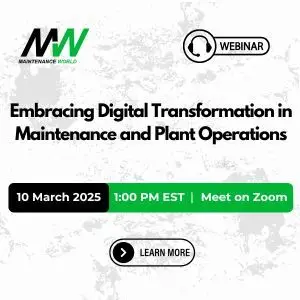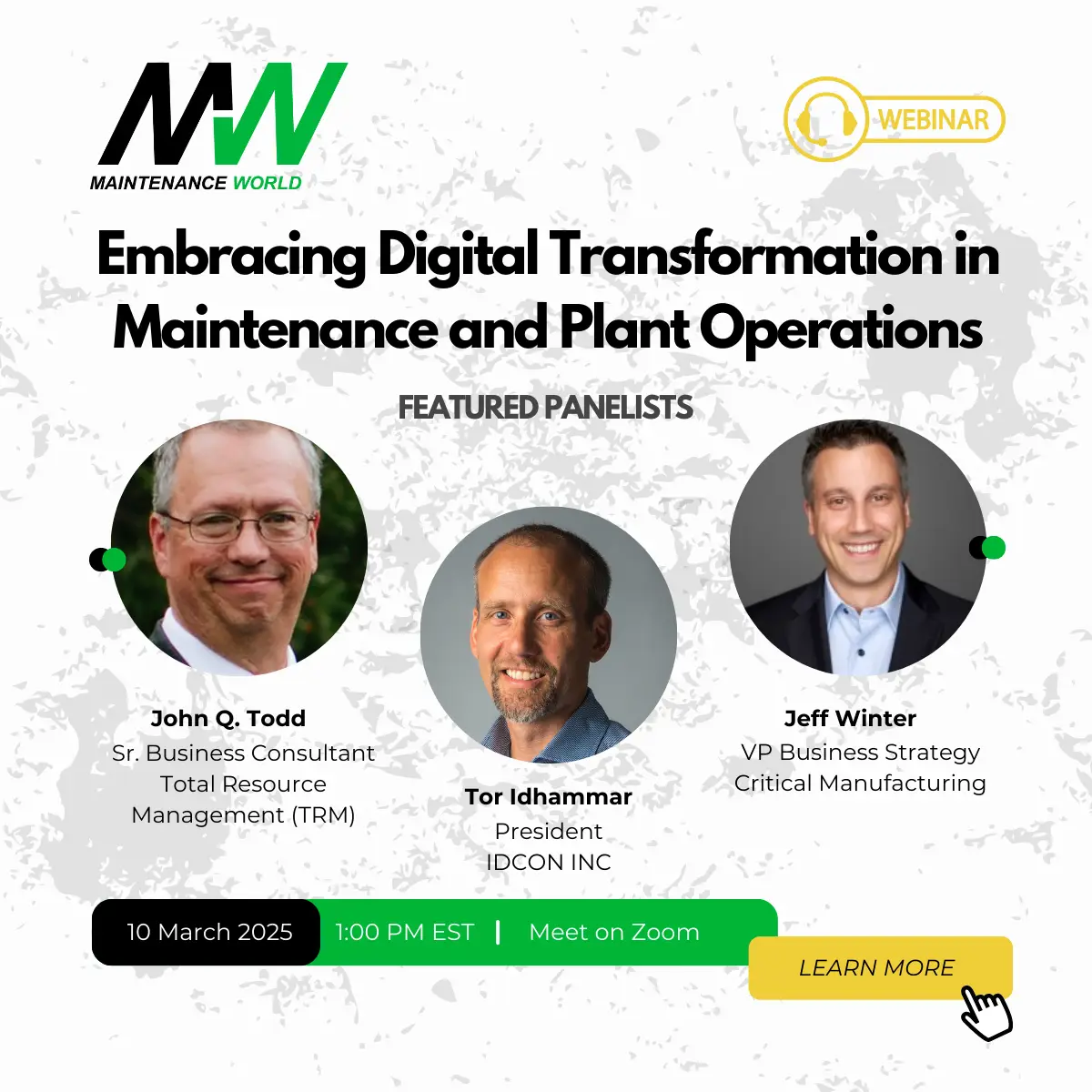TPM and Tecate: The New Translation
reliableplant.com
Total Productive Maintenance (TPM) does not have a great reputation in American industry these days.
A study conducted in 2006 by The Manufacturing Research Center showed that only 38 percent of U.S. manufacturers surveyed were currently implementing TPM. Of those implementing TPM, 37 percent said they weren’t making as much progress as expected in this area and 27 percent said they were hardly making any progress. Only 8 percent called their progress “excellent”.
Of respondents who said they were not implementing TPM, 24 percent characterized it as “not important at the present time”, 12 percent said they “already had done it”, 19 percent were planning to do it next year, 37 percent “may do it in the future” and 8 percent never heard of it.
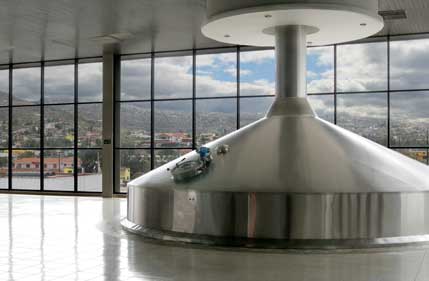
Other TPM surveys in recent years elicited these additional statistics:
– 27 percent of respondents said TPM was a current business initiative, yet only 6 percent claimed to be fully operating it;
– 5 percent of respondents characterized TPM as their plant’s approach to maintenance and reliability.
Not exactly a ringing endorsement.
Maybe the problem isn’t Total Productive Maintenance, per se. Maybe it’s the way this initiative is being used. Most plants and companies that “have implemented” or “are implementing” or “won’t implement” TPM translate it purely as:
- a program to clean and paint machines; OR,
- giving operators some basic lubrication and maintenance tasks; OR,
- a means to put people “to good use”; OR,
- a reason to cut maintenance staff.
Shortsighted approaches such as these were never the intention of the Japanese Institute for Plant Maintenance when it developed TPM in 1971 as “a path to better manufacturing, with a constant focus on the creation of value.”
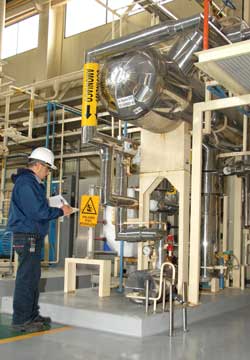
The true translation — might it be proper to say a new and improved translation? — is being used today by Cervecería Cuauhtemoc Moctezuma, one of the largest brewers of beer in Latin America. Known throughout this company as Mantenimiento Alto Desempeño (MAD), or translated as High-Performance Maintenance, the concept of TPM is alive and well at the company’s six plants in Mexico. Perhaps the best example is at CCM’s brewery in Tecate, located a short drive from the U.S.-Mexico border on the Baja California peninsula. CCM Tecate — which brews six beer brands, including Tecate, Dos Equis, Carta Blanca and Sol — interprets MAD/TPM to mean:
- clean, inspect, lubricate and control contamination; AND,
- the best practices of engineering and maintenance; AND,
- a focus on the tasks that add value; AND,
- design for reliability and maintainability; AND,
- continuous improvement of equipment and processes; AND,
- failure detection, problem-solving and root cause analysis; AND,
- continual development of employees’ skills, abilities and careers; AND,
- everyone is on the same page and speaks the same language; AND,
- predictive maintenance; AND,
- formal assessments to gauge program maturity and sustainability.
“It means we are all responsible for guaranteeing the total effectiveness of the equipment — maintenance, production, top management, human resources … everyone,” says plant maintenance manager Manuel Sanchez.
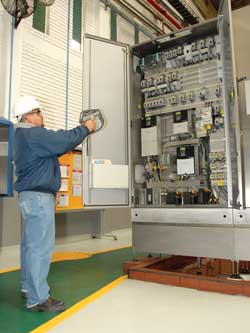
This is an all-consuming passion to improve reliability, productivity, safety and ecology, and the bottom line.
“MAD does not mean ‘crazy’. MAD means ‘smart’,” says Sanchez.
Comprende? You will.
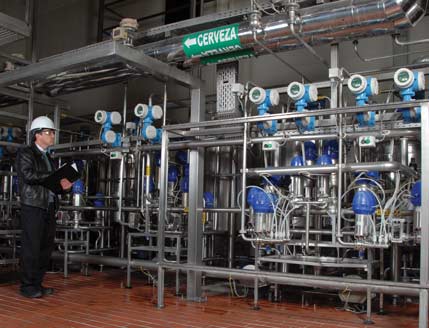
A CLEAN SLATE
MAD emerged as a CCM improvement tool several years after a series of events changed the complexion of the company. The most noteworthy event occurred in 1998 as CCM took action to restructure the contract it held with the union for maintenance and production workers. The result was new language that allowed CCM to expand the functions and responsibilities of hourly workers. This was done to shift operators away from being single-machine, single-task “autobots” and was not tied to thoughts of TPM.
As a result of these events, many veteran workers retired or left to seek employment elsewhere. The restructured workforce was quite young. For example, CCM Tecate has stabilized its turnover rate after a period of churn. Its plant population today has an average age of 33 and an average tenure of 10 years. The maintenance crew has an average age of 27 (see sidebar below).
In the aftermath of the shakeup, focus was placed on growth and achieving greater efficiencies at the breweries. In 2000, maintenance and reliability leaders at CCM headquarters in Monterrey sculpted the Japan institute’s TPM philosophy into MAD. The company’s largest brewery, in Monterrey, served as the pilot site. The initiative spread to Tecate and sites in Guadalajara, Navojoa, Toluca and Orizaba in 2001.
Each plant was wary of TPM at first, and may have settled for a suboptimized version of TPM had it not been for people like Sanchez, who served as the company’s MAD implementation coordinator during those years. Persistence and communication skills brought down the roadblocks to TPM erected by production and plant leaders.
“The top managers at plants said, ‘The operators have many new activities (stemming from the contract revisions). It’s very difficult to continue giving them more,'” says Sanchez. “We needed to convince them that these maintenance activities are part of the operation of the equipment. Care of the equipment means simpler operation. Done correctly, it makes operators’ jobs easier, it makes them more efficient and it improves key plant metrics. It was our responsibility to explain and show and describe and convince.”
Similar strategies were used to convince operators in the brewing, filling and packaging lines.
Change in job function wasn’t confined to production. MAD also turned around the structure and function of maintenance.
“Ten years ago, performance was good, but it was strictly focused on preventive maintenance,” says Sanchez. “We didn’t have maintenance engineering. Planning existed only partially. We didn’t address needs and issues before capital equipment was purchased and installed. We didn’t embrace the concept of continuous improvement. All of that has changed.”
Today, plant maintenance organizations are comprised of three intertwined “chain links”.
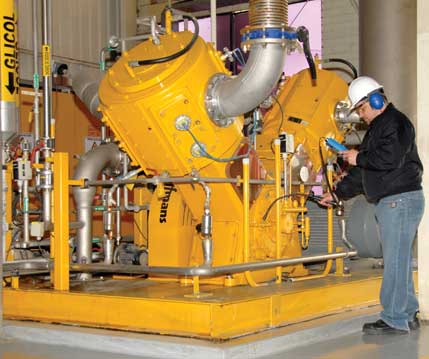
Maintenance engineering personnel analyze, develop and revamp the asset care plans for plant equipment. They lead root cause and problem-solving events that get to the heart of equipment problems, and carry the findings into future reliability-enhancement strategies. As Sanchez says, they focus on the “why” of maintenance.
Maintenance planning personnel create efficiencies by managing how work orders are planned and scheduled. They assemble kits that include all of the parts and instructions for a work order. Sanchez says proper planning focuses on the “what”, “where” and “how” of maintenance, while scheduling focuses on the “who” and “when”.
Maintenance execution team members then use their technical skills to implement well-designed, well-planned maintenance activities. They use analysis techniques to get to the heart of equipment failures and provide important feedback that improves the process.
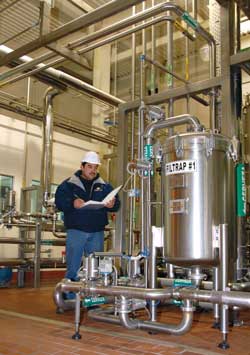
AT CCM, OEE IS ETE
In his current role as maintenance manager at CCM Tecate, Sanchez leads a high-energy team of 80 department members who are driven to impact the total effectiveness of equipment (or ETE, for Efectividad Total de los Equipos) and support the six pillars that comprise MAD.
ETE is better known in the U.S. as overall equipment effectiveness (OEE). At CCM, it is measured two ways. ETE Planta is derived from taking the percentage of plant availability times the percentage of plant performance times the percentage of plant quality. ETE Total is more stringent and multiplies the three components of ETE Planta along with the percentage of plant capacity utilization (plant and product demand is the extra factor).
“ETE is at the heart of the MAD philosophy,” he says. “All of the work that maintenance does and operations does influences the components of ETE.”
Daily work that makes a difference is encompassed in the six pillars — CCM’s building blocks of maintenance and reliability excellence whose purpose is to:
- Improve, through operations and maintenance, the basic conditions of the equipment
- Detect and diagnose problems and opportunities for improvement
- Facilitate, optimize and look to reduce maintenance
- Facilitate maintenance engineering and apply continuous improvement to the equipment
- Increase the flexibility of the processes
- Contribute to safety and ecology
- An explanation of the six pillars follows.
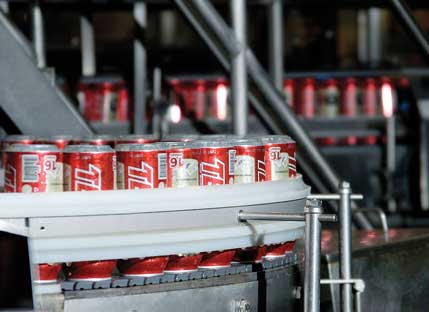
PILLARS OF STRENGTH
Maintenance management system is the first pillar of MAD. Its deliverables are in the definition and application of best maintenance and reliability practices, and in focusing on tasks that add value. The goal is to create the system that supports world-class maintenance and reliability.
The delineation and interplay of the three maintenance functions is found in this pillar, as are the guidelines for effective planned maintenance. Planning is captained by three full-time staffers and generated through the maintenance component of the company’s SAP system, which must be fully optimized as a work order and machine history tool.
Practices such as just-in-time procurement of MRO products through strategic distribution partners and kitting (100 percent of all planned work orders go this route) streamline the “job planned to job completed” process and lowers inventory and cost.
“We want people in each function to focus on the tasks that add value, not on the tasks that do not add value,” says MAD coordinator Edgard Espinoza. “We don’t want a mechanic searching for or gathering parts. We want to make it easy for him. We want to eliminate the non-value-added tasks in everyone’s routines.”
Improvement of equipment and processes is the second pillar. It provides the structure and tools to analyze failures, solve problems and work on formal improvement projects.
As in the first pillar, the push is to focus time and activities in the most efficient way. Is a mechanical failure a chronic issue or a sporadic issue? Does it have a high impact in terms of cost, downtime or safety, or is it relatively benign? Is it an issue in need of immediate attention or is it an issue that you can live with until a to-be-determined date? Team members are highly trained to use tools such as Pareto analysis, kaizen, root cause analysis, failure modes and effects analysis, and five-why problem-solving in order to get the real answers to these and other questions.
Improvement projects, generated to address specific needs or opportunities, are completed by teams or individuals in maintenance.
“Projects improve the equipment and improve the results of the company,” says Alberto Diaz, a predictive maintenance technician who Sanchez dubs “the coordinator of solutions for chronic problems.”
“The project might incorporate new equipment or new technology into the process. It can involve construction, installation, implementation and obtaining results. The maintenance department is responsible for these projects.”
Maintenance has completed 100 projects since 2003, including 43 in 2007. Plant employees can access an intranet site to track the status of ongoing projects and view the results of completed ones.
“Successful projects are sustainable and obtain the goals of improved productivity, quality and safety and reduced costs,” says Espinoza. “When you sustain the goal, then you have solved the problem.”
Early administration of the equipment is the third pillar. Its emphasis is on the proactive pursuit of maintainability and reliability in new equipment.
“Traditionally, you have problems in the early stages after you bring new equipment on line,” says maintenance engineer Adolfo Esquer. “The problems either come from the supplier, or they are created in the installation and implementation phases.”
CCM Tecate assembles a cross-functional team, led by maintenance engineering, and works with the original equipment manufacturer to design the purchased machine to the plant’s maintenance and reliability specifications.
“We dedicate many men to identifying potential problems,” says Sanchez. “The problems are eliminated before the equipment is brought into the plant and before it is turned over to production. If you spend a little bit more money on the front end, it saves you more on the back end.”
Project details are entered into the computerized maintenance management software system and accessed for future equipment purchases.
“We want to learn from previous projects and not have to reinvent the wheel each time,” says Espinoza.
Develop the skills and abilities of the personnel is the fourth pillar. As Sanchez alluded to earlier, MAD does mean smart. Here, maintenance takes the lead in improving the technical, diagnostic and problem-solving abilities of its employees and those in operations.
More than 80 courses are offered to new and veteran employees on topics such as pump maintenance, bearings, boiler operation, failure detection, instrumentation/ controls and mechanical basics.
The company performs assessments to identify areas of need and career enhancement. Courses are administered through a training and administration intranet site called SICAP (Sistema de Capacitación de Personal).
On average, Tecate employees took four courses totaling 79 hours in 2007.
“This is personal utilization,” says Sanchez. “Are we truly utilizing our employees to their capability and potential? Through these courses, we can.”
Training also comes through One-Point Lessons — visual, one- to two-page instruction manuals that provide operators knowledge on a single component of their equipment or a single facet of operator-based maintenance.
Autonomous maintenance is the fifth pillar. This is the work most commonly associated with Total Productive Maintenance. Within MAD, it contains the guidelines for operators to safely clean, inspect and lubricate (CIL) their machines, as well as to eliminate the potential sources of contamination.
The pillar begins with an examination of the equipment within a particular process. Maintenance responsibilities are divided between operators and mechanics based on the technical nature of the equipment, the operator’s experience with the equipment, safety issues (including electrical and mechanical hazards) and workload (the number of activities the operator can fit into his or her schedule).
Operators are then trained in inspection techniques for their particular piece(s) of equipment. They are educated on proper lubrication practices and methods to avoid lubrication-induced contamination.
Checklist sheets serve as a daily reminder not only of required CIL tasks but of the steps required to complete the tasks. Pictures and diagrams take the operator through the proper sequence. The sheet also includes an area for the operator to provide comments or report any abnormalities.
Additionally, this pillar stresses that operators take ownership of their machines by leading improvement projects in their work area. Every two months, the plant highlights projects that impacted productivity, reliability, quality or safety. An annual awards program provides cash prizes for the year’s best ideas.
Assurance of practices is the sixth pillar. The brewery performs an internal audit every two months to gauge the health of MAD. A comprehensive annual audit is performed by a team led by assessors from corporate headquarters. The yearly assessment is based on a model constructed by the Japan Institute of Plant Management and involves evaluated progress in 140 categories. The categories are derived from the MAD pillars.
“Can you verifiably show that you are doing this within Pillar 1?” says Sanchez. “And if you are doing this, at what level are you?”
A score of zero to 1 puts you at the preparation level, 1 to 2 is development, 2 to 3 is consolidation, 3 to 4 is stabilization and 4 to 5 is excellence.
A comprehensive evaluation score is calculated from the sub-scores in the 140 categories and used to denote program maturity and growth.
“This process verifies where you stand,” says Sanchez. “You may think that you are good, but the end results may show otherwise. The numbers don’t lie.”
Tecate scored a 1.9 in its 2003 audit, then followed that up with a 2.7 for 2004, a 3.65 for 2005 and a 3.89 for 2006. It cracked the “excellence” level with a 4.03 in 2007. As you can see, the more mature the program, the tougher it is to raise the figure. At this stage of the game, it’s about sustainment and gaining hundredths of a percentage point.
CHEERS TO CCM TECATE
Company: Cervecería Cuauhtemoc Moctezuma, a division of FEMSA, the largest beverage company in Latin America.
Focus plant: CCM Tecate brewery in Tecate, Mexico. The plant, located in Baja California, was founded in 1944. It includes nearly 800,000 square feet of facilities on a 6.4-acre property. The plant runs 24 hours a day, seven days a week.
Plant employment: Approximately 400 employees, including 80 in the maintenance department (60 technicians and 20 salary staff). Hourly maintenance and production workers are members of the Confederación Nacional de Sindicatos de Mexico union.
Plant products: The plant brews six beer brands – Tecate, Tecate Light, Dos Equis Lager, Dos Equis Amber, Carta Blanca and Sol. It produces 390,000 hectoliters (4.6 million cases, or 10.3 million gallons) of beer per month. Fifty-five percent of the plant’s total production is sold and consumed in Mexico and 45 percent is shipped and consumed internationally.
FYI: More than 30,000 tourists visit the brewery every year. … The Tecate beer brand was launched in 1954.
TPM IS A SOUND INVESTMENT
One way that the Tecate maintenance department has gained ground in recent years, and will continue to do so in 2008 and beyond, is through predictive maintenance. Sanchez puts PdM utilization inside MAD because these tools dovetail nicely with each pillar. Used properly, PdM is a key component of planned, scheduled maintenance; can be used to improve the health of equipment and processes; should be part of the M&R strategy for every new piece of equipment; can be on the training curriculum; and works to provide volume to issues found by operators during autonomous maintenance tasks.
The brewery’s PdM program currently includes vibration analysis, infrared thermography, oil analysis and ultrasound.
“Predictive maintenance is an investment in reliability,” says Diaz, who oversees the program along with Carlos Valdez.
Vibration analysis is used extensively on the plant’s 1,137 electric motors. Diaz and Valdez employ DLI Engineering’s Watchman DCX data collector and ExpertALERT software to monitor the condition of big, critical motors (100 to 1,000 horsepower). They use a Vibrotip data collector from Pruftechnik AG for smaller, less-critical motors.
Infrared thermography is used on regular routes to check the site’s electric boards and stations. The ThermoView Ti30 thermal imager from Raytek is the tool of choice. A total of 222 hot spots have been detected in the past three years.
Oil analysis is accomplished with an internal/external strategy. Diaz and Valdez use the OilCheck TMEH 1 handheld instrument from SKF to verify oil condition and perform quick checks for mechanical wear and loss of lubricating properties. More extensive studies and analysis of samples from critical equipment are performed off-site by Mobil and Lubrication Engineers. Work in this area has helped the plant greatly reduce its lubrication consumption. Oil is changed as needed rather than on a calendar basis.
Ultrasonic analysis is used to pinpoint leaks in compressed air, carbon dioxide and steam pipes, as well as to detect electrical arcing conditions and vibration in electric motor bearings. Measurements are taken with the 170M Digital Detector system from SDT North America. These steps have been instrumental in cutting energy usage and costs.
“We are increasing the health and life of our equipment through these tools,” says Diaz. “This is a growing area for us. The more that we use PdM, the more that we decrease corrective maintenance and preventive maintenance.”
Eliminate PMs?
“We are adding reliability by eliminating preventive maintenance,” explains Sanchez. “We have saved 2,600 man-hours by doing this; 2,600 hours that had been set aside for PMs are no longer necessary. Instead, we are using a much smaller amount of time through PdM. The saved time can be used for other activities.”
Sanchez says the department has eliminated 90 percent of preventive work orders for bearings and 100 percent of the orders for electric motors.
“We’ve increased bearing life, saved money and hours, and reduced work orders and paperwork,” he says.
CCM TECATE MAKES THE MOST OF A YOUNG WORKFORCE
Production and maintenance workers at Cervecería Cuauhtemoc Moctezuma’s brewery in Tecate, Mexico, have an average age of around 30 years old. Maintenance manager Manuel Sanchez says there are challenges and benefits to having such a young workforce.
The challenges, of course, relate to technical knowledge and experience. A 25-year-old mechanic is generally not going to be as technically skilled as a 50-year-old mechanic who has been working on plant equipment for 25 years. While an equipment problem may be new to the young mechanic, the veteran has most likely solved it multiple times in his plant career.
On the other side of the coin, the young workforce has grown up in the age of computers and is very comfortable learning and adopting new technologies. Sanchez says this group’s energy and attitude are major pluses. “They are helping to usher in a new culture within the company,” he says.
TPM MAKING A DIFFERENCE
Call it MAD or call it TPM. Mantenimiento Alto Desempeño has profoundly impacted productivity, reliability and growth at CCM Tecate.
The numbers tell a story that requires no translation.
ETE Planta (traditional OEE): Up 6.48 points in two years (from 69.77 percent in January 2006 to 76.25 in December 2007).
ETE Total (OEE plus demand): Up 17.06 points in two years (from 23.79 percent in January 2006 to 40.85 in December 2007).
Volume: Up 35 percent since 2001 (2.97 billion hectoliters produced in 2001 vs. 4.0 billion hectoliters produced in 2007).
Cost of maintenance per unit produced: Down 26 percent in three years (22.72 pesos per hectoliter in 2004 vs. 16.92 in 2007).
Kilowatt-hours of energy per hectoliter produced: Down 11 percent (7.8 in 2003 to a company-best 6.97 in 2007).
Downtime: Down more than 33 percent in the past few years (from 15 percent to between 5 and 10 percent).
Capital investment: The plant has received $50 million in capital investments over the past six years. (Isn’t that the ultimate endorsement for TPM?)
“The top managers are convinced that MAD is a powerful philosophy that gets results,” says Sanchez. “It’s more than just a great culture. It’s about great results.”
The department hopes to build on those results in the next 12 months by:
1) Expanding the use of Reliability-Centered Maintenance (RCM) to identify and establish the operational, maintenance and capital improvement policies that will manage the risks of equipment failure most effectively.
“We have dabbled in it previously,” says Sanchez. “We will formally apply it in a pilot area in 2008 and grow it from there.”
2) Addressing opportunities in the maintenance tool cribs.
“We need to improve our levels of spare parts in inventory,” says Espinoza. “We need to adjust minimum/maximum levels and improve our strategic relationships with suppliers. This is all part of our goal to reduce the cost of maintenance.”
3) Expanding PdM to include motor circuit analysis, bearing lubrication monitoring and the general pursuit of best practices in machinery lubrication.
“We are working to analyze and rationalize everything — from our purchasing practices to our PM activities,” says Sanchez. “Everything has to make sense.”
Comprende?
If your TPM efforts or beliefs have gotten lost in translation, you don’t need an interpreter. Success comes by using it as it was originally intended – as a path to better manufacturing, with a constant focus on the creation of value.
EVERYONE SPEAKS THE SAME LANGUAGE
Cervecería Cuauhtemoc Moctezuma believes operators must be trained to not only know how their equipment works, but also to understand the name and function of its various components.
“By doing so, they can convey their needs in the language of the technicians. They can speak the same language,” says Manuel Sanchez, the maintenance manager for CCM’s brewery in Tecate, Mexico. “That improves communication between the two departments. When an operator finds a problem, he or she can now be more specific. Instead of simply telling the technician, ‘My machine isn’t working,’ the operator can now express to the technician that it isn’t working because a specific failure mode is occurring and is localized within a specific component.”
ARE YOU A TRANSLATOR?
Match up the Spanish maintenance words on the left to their English translation on the right.
Aceite Availability
Ahorros Reliability
Bombas Screwdriver
Causa raíz Oil
Confiabilidad Maintenance
Destornillador Machines
Disponibilidad Engineering
Equipos Bearings
Ingeniería Cleaning
Limpieza Safety
Mantenimiento Root cause
Máquinas Equipment
Rodamientos Savings
Seguridad Pumps
Answers: Aceite (Oil); Ahorros (Savings); Bombas (Pumps); Causa raíz (Root cause); Confiabilidad (Reliability); Destornillador (Screwdriver); Disponibilidad (Availability); Equipos (Equipment); Ingeniería (Engineering); Limpieza (Cleaning); Mantenimiento (Maintenance); Máquinas (Machines); Rodamientos (Bearings); Seguridad (Safety).
Related Articles
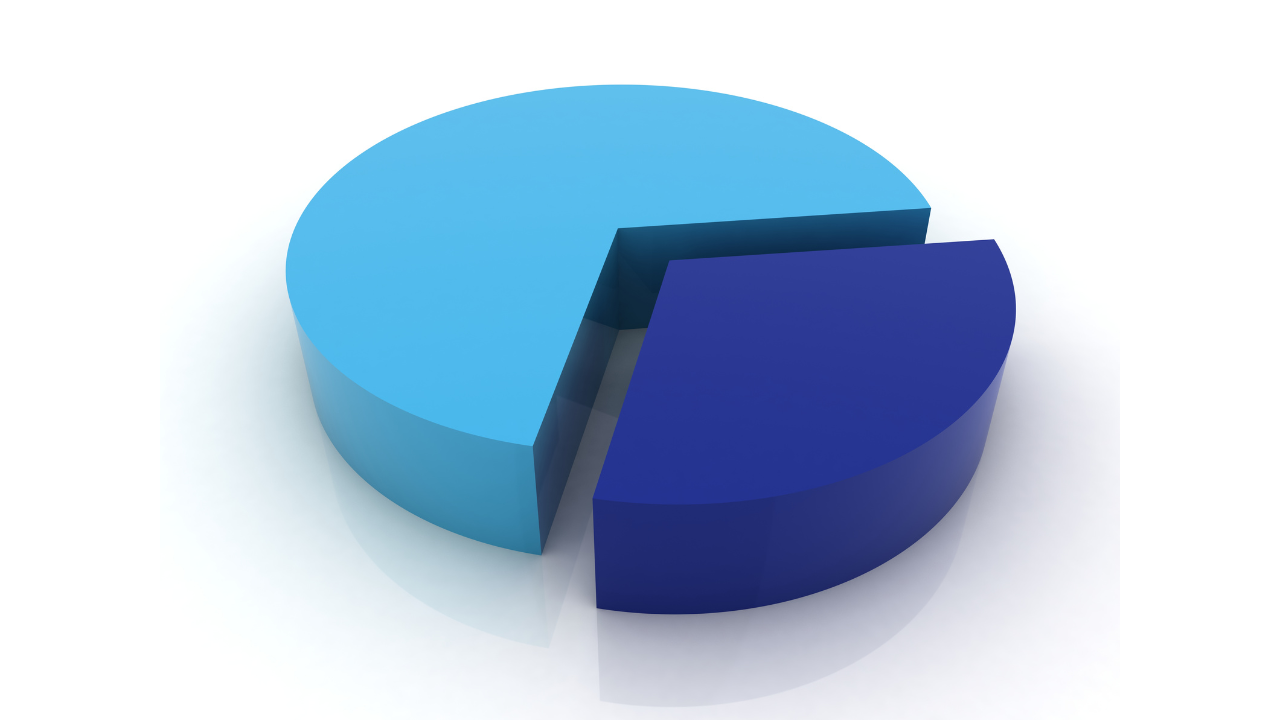
How to Fix the 70/30 Phenomenon

Zen and the Art of Managing Maintenance

Why do maintenance improvement initiatives fail to deliver? (Hedgehog or Fox?)

Why Maintenance Improvement Efforts Fail

TPM and RCM: Whirled Class


